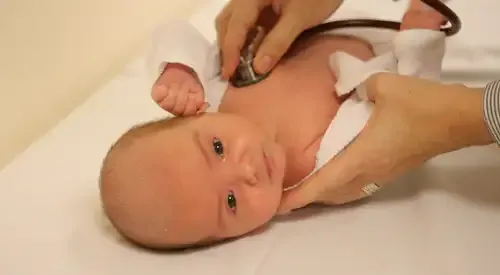Measles
"It is very important to comply with the vaccination schedule for children. It avoids infectious diseases, some with serious complications."
DR. REYES LÓPEZ DE MESA
SPECIALIST. PEDIATRICS DEPARTMENT

How is measles spread?
Measles is an exanthemic (skin rash), febrile, acute and highly contagious disease.
It is transmitted from the sick person to the healthy person by droplets from the airways (Pflügge drops) when talking, sneezing, coughing.
The infected person begins to spread on the 9th-10th day when the prodromal period begins and stops about four days after the start of the rash.

What are the symptoms of measles?
There are four periods in the course of the disease:
1st Incubation period: lasts 10-14 days and is normally asymptomatic.
2nd prodromal or catarrhal period: it lasts about 4 days and is characterized by
- High fever that then decreases to rise again, before the exanthema.
- General malaise.
- Nasal mucous membrane cold (rhinitis, nasal discharge) and conjunctival (tearing, photophobia, eye congestion), dry irritating cough. All this gives rise to the typical "facies sarampionosa".
- Exanthema: small pink spots that are seen mainly on the veil of the palate, although they exist in other mucous membranes.
- Koplik's spots: small spots with white center in mucous of internal face of cheeks and lips. They appear at the end of this period and before the rash appears. They are exclusive of this disease.
- Laterocervical lymph node swelling, but less intense than in rubella.
3º Exanthemic period: it lasts about 5 days with fever that rises, irritability, somnolence, worsening of the catarrhal symptoms, general malaise, anorexia (little appetite). It appears maculo-papular exanthema, confluent, reddish, which begins in the face and extends to the rest of the body, including palms of hands and soles of feet. There are varieties, according to this exanthema, such as the reticulous or hemorrhagic measles.
4º Scaling period: it has variable duration. It diminishes the fever, a generalized improvement takes place, disappearance of the exanthema and appearance of a furfurácea descamation (skin with flour aspect).
Do you have any of these symptoms?
You may have measles
What is the prognosis for measles?
Although it is generally a benign disease, the following complications can sometimes occur:
Neurological:
- Encephalitis: 1 out of every 1,000-2,000 cases, it causes headache, fever, convulsions, altered consciousness...
- Subacute sclerosing panencephalitis: 1.5 out of 100,000 cases, is a late complication appearing 2-17 years after suffering from measles.
Respiratory: these are the most frequent and may be due to secondary bacterial superinfections. Among them: laryngitis, bronchitis, bronchopneumonia, pneumonia...
Conjunctivitis that progresses to corneal ulceration, blindness...
Digestive disorders: vomiting, diarrhea, stomatitis.
There is no knowledge that measles, in pregnant women, produces congenital malformations in the fetus. If it could be responsible for miscarriages or premature births
Who can suffer from it?
Mainly in childhood (2-6 years), but since the massive vaccination of children before school age, its incidence has decreased by more than 95% and affects more children under 15 months (not yet vaccinated) and older children not vaccinated or who have not had contact with the virus.
It is very rare in infants under 6-8 months, since they are protected by antibodies passed through the placenta by their immune mother.
How is measles diagnosed?

The diagnosis of measles is made primarily and almost always by the clinic.
The observation of the "Koplik spots", small whitish spots that appear on the inside of the cheeks in the early stages of this disease, is also a diagnosis of measles.
Sometimes, when the diagnosis is not very clear, a blood test can be performed to detect measles antibodies in serum.
The differential diagnosis should be made with other exanthemic diseases such as rubella, sudden exanthema or scarlet fever.
How is measles treated?
There is no specific treatment.
Only symptomatic: antipyretics, drinking fluids, low light (for eye discomfort such as photophobia)...
Where do we treat it?
IN NAVARRA AND MADRID
The Department of Pediatrics
of the Clínica Universidad de Navarra
All our specialists work exclusively and, in addition, since we have all the technology in the same center, we offer the performance of tests and diagnosis in less than 72 hours.
We have a team of highly qualified professionals to attend the different specialized units: Oncopediatrics, Neuropediatrics, Endocrinopediatrics, Neonatology, etc.
Organized in specialized units
- Neonatology Area.
- Pediatric Endocrinology.
- Pediatric Cardiology.
- Pediatric Neuropediatrics.
- Digestive and pediatric nutrition.
- General and preventive pediatrics.
- Pediatric Pneumology.

Why at the Clinica?
- Comprehensive care of the child.
- Professionals who are experts in the different areas for a better diagnosis and treatment.
- Equipped with the latest technology for newborn care.























